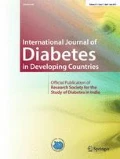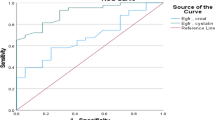Abstract
Microalbuminuria is a sensitive marker to detect early nephropathy in diabetes mellitus. Cystatin C correlates better than serum creatinine with microalbuminuria in type 1 diabetes mellitus (T1D). We evaluated the correlation between microalbuminuria, serum cystatin C (Cyc-C), and serum creatinine (SCr) in diabetic children. A hundred patients with stable T1D and 66 sex-matched healthy children were entered in the study between September 2008 and February 2011. Fasting blood sample was drawn for HbA1C, creatinine, and cystatin C. A. 24-h urine aliquot was collected to measure microalbumin, creatinine, and volume. Glomerular filtration rate estimated based on creatinine (eGFRcr), cystatin C (eGFRCyst C), and creatinine + cystatin C (eGFRCyst C + Cr). Binary logistic regression analysis, chi-square, ANOVA, Student’s t test, and nonparametric median tests were used to analyze data. P < 0.05 was considered significant. Medians serum creatinine and cystatin C of T1D group were significantly different from controls (P < 0.05). Overall, medians eGFRCyst C were higher than eGFRcr, or eGFRCyst C + Cr. Thirty-six children with T1D had microalbuminuria. There was a correlation between microalbuminuria and eGFRCyst C (<60 and >130 ml/min/1.73 m2) (P < 0.05). Medians eGFRcr were significantly lower than medians eGFRCyst C in T1D, regardless of microalbuminuria (P < 0.05). Chronic kidney disease classification according to eGFRcr and eGFRCyst C were not matched (P < 0.05). GFR in healthy children was overestimated by eGFRCyst C and underestimated by eGFRcr. There was higher correlation between abnormal eGFRCyst C and microalbuminuria in diabetic children. eGFRCr detected higher rate of GFR less than 60 ml/min/1.73 m2.

Similar content being viewed by others
References
Pishdad GR. Low incidence of type 1 diabetes in Iran. Diabetes Care. 2005;28:927–8.
Shakiba M, Afkhami Ardekani M, Orafa AM. A study of the prevalence of micro and macro albuminuria in diabetic patients referring to the diabetic centre in Yazd. J Shahid Sadoughi Univ Med Sci Health Serv. 2003;10:20–4.
Ledson T, Howse MLP, Roberts NB, Kemp GJ, William PS. Cystatin C as a surrogate for glomerular filtration rate in the presence of proteinuria. NDT Plus. 2008;1:194–5.
Dharnidharka VR, Kwon C, Stevens G. Serum cystatin C is superior to serum creatinine as a marker of kidney function: a meta-analysis. Am J Kidney Dis. 2002;40:221–6.
Roos JF, Doust J, Tett SE, Kirkpatrick CM. Diagnostic accuracy of cystatin C compared to serum creatinine for the estimation of renal dysfunction in adults and children—a meta-analysis. Clin Biochem. 2007;40:383–91.
Bökenkamp A, Laarman CA, Braam KI, van Wijk JA, Kors WA, Kool M, et al. Effect of corticosteroid therapy on low-molecular weight protein markers of kidney function. Clin Chem. 2007;53:2219–21.
Cimerman N, Brguljan PM, Krasovec M, Suskovic S, Kos J. Serum cystatin C, a potent inhibitor of cysteine proteinases, is elevated in asthmatic patients. Clin Chim Acta. 2000;300:83–95.
Manetti L, Pardini E, Genovesi M, Campomori A, Grasso L, Morselli LL, et al. Thyroid function differently affects serum cystatin C and creatinine concentrations. J Endocrinol Invest. 2005;28:346–9.
Holmquist P, Torffvit O, Sjöblad S. Metabolic status in diabetes mellitus affects markers for glomerular filtration rate. Pediatr Nephrol. 2003;18:536–40.
Karagiannis A, Mikhailidis DP, Tziomalos K, Kakafika AI, Athyros VG. Has the time come for a new definition of microalbuminuria? Curr Vasc Pharmacol. 2008;6:81–3.
Toto RD. Microalbuminuria: definition, detection, and clinical significance. J Clin Hypertens (Greenwich). 2004;6 Suppl 3:2–7.
Zappitelli M, Parvex P, Joseph L, Paradis G, Grey V, Lau S, et al. Derivation and validation of cystatin c-based prediction equations for GFR in children. Am J Kidney Dis. 2006;48:221–30.
Oddoze C, Morange S, Portugal H, Berland Y, Dussol B. Cystatin C is not more sensitive than creatinine for detecting early renal impairment in patients with diabetes. Am J Kidney Dis. 2001;38:310–6.
Pucci L, Triscornia S, Lucchesi D, Fotino C, Pellegrini G, Pardini E, et al. Cystatin C and estimates of renal function: searching for a better measure of kidney function in diabetic patients. Clin Chem. 2007;53:480–8.
Zhang PP, Zhan JF, Xie HL, Li LS, Liu ZH. Evaluation of glomerular filtration rate using cystatin c in diabetic patients analysed by multiple factors including tubular function. J Int Med Res. 2010;38:473–48.
Peralta CA, Shlipak MG, Judd S, Cushman M, McClellan W, Zakai NA, et al. Detection of chronic kidney disease with creatinine, cystatin c, and urine albumin to creatinine ratio and association with progression to end-stage renal disease and mortality. JAMA. 2011;305:1545–52.
Glassock RJ. Is the presence of microalbuminuria a relevant marker of kidney disease? Curr Hypertens Rep. 2010;12:364–8.
Van Deventer HE, Paiker JE, Katz IJ, George JA. A comparison of cystatin c and creatinine bases prediction equations for the estimation of glomerular filtration rate in black South Africans. Nephrol Dial Transplant. 2011;26:1553–8.
Niewczas MA, Ficociello LH, Johnson AC, Walker W, Rosolowsky ET, Roshan B, et al. Serum concentrations of markers of TNF-alpha and FAS-mediated pathways and renal function in nonproteinuric patients with type 1 diabetes. Clin J Am Soc Nephrol. 2009;4:62–70.
Danziger J. Importance of low-grade albuminuria. Mayo Clin Proc. 2008;83:806–12.
Ficociello LH, Perkins BA, Roshan B, Weinberg JM, Aschengrau A, Warram JH, et al. Renal hyperfiltration and the development of microalbuminuria in type 1 diabetes. Diabetes Care. 2009;32:889–93.
Jerums G, Premaratne E, Panagiotopoulos S, MacIsaac RJ. The clinical significance of hyperfiltration in diabetes. Diabetologia. 2010;53:2093–104.
Stevens LA, Schmid CH, Zhang YL, Coresh J, Manzi J, Landis R, et al. Levey AS development and validation of GFR-estimating equations using diabetes, transplant and weight. Nephrol Dial Transplant. 2010;25:449–57.
Zelmanovitz T, Gerchman F, Balthazar AP, Thomazelli FC, Matos JD, Canani LH. Diabetic nephropathy. Diabetol Metabc Syndr. 2009;1:10.
Perkins BA, Ficociello LH, Ostrander BE, Silva KH, Weinberg J, Warram JH, et al. Microalbuminuria and the risk for early progressive renal function decline in type 1 diabetes. J Am Soc Nephrol. 2007;18:1353–61.
Mojiminiyi OA, Abdella N. Evaluation of cystatin C and beta-2 microglobulin as markers of renal function in patients with type 2 diabetes mellitus. J Diabetes Complications. 2003;17:160–8.
Nowak N, Szopa M, Thanabalasingham G, McDonald TJ, Colclough K, Skupien J, et al. Cystatin C is not a good candidate biomarker for HNF1A-MODY. Acta Diabetol. 2012. doi:10.1007/s00592-012-0378-1.
Rohani F, Hooman N, Moradi S, Mobarra M, Najafizadeh M, Tatarpoor P. The prevalence of pre-hypertension in children with type 1 diabetes mellitus. Int J Prev Med. 2014;5 Suppl 1:S44–9.
Hooman N, Roohani F, Moradi S, Mobarra M, Najafizadeh M. Cystatin C as an early marker of diabetic nephropathy in children with type 1 diabetes mellitus. Pediatr Nephrol. 2013;28:1533–689.
Acknowledgments
This study has been supported by Endocrine Research Centre (Firouzgar), Institute of Endocrinology and Metabolism, Iran University of Medical Sciences, grant no. 653 dated 2009. The abstract of this article has been presented as poster in the 16th congress of International Pediatric Nephrology Association held in Shanghai, China from 30 August to 3 September 2013 [29].
Conflict of interest
None.
Author information
Authors and Affiliations
Corresponding author
Rights and permissions
About this article
Cite this article
Rohani, F., Hooman, N., Moradi, S. et al. Glomerular filtration rate-based cystatin C compared to microalbuminuria to detect early stage of diabetic nephropathy in children with type 1 diabetes mellitus. Int J Diabetes Dev Ctries 35 (Suppl 3), 342–348 (2015). https://doi.org/10.1007/s13410-015-0297-0
Received:
Accepted:
Published:
Issue Date:
DOI: https://doi.org/10.1007/s13410-015-0297-0



